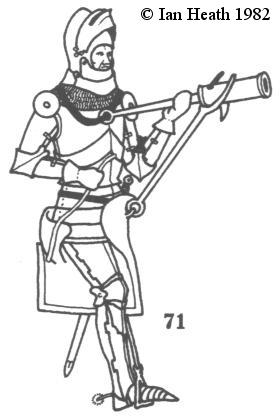
Amazon Audible Gift Memberships
MOUNTED HANDGUNNER
An extract from Armies of the Middle Ages, volume 1by Ian Heath



71. MOUNTED HANDGUNNER
Though some cavalry were carrying primitive firearms from the mid-15th century (the source of this figure, for example, dates to 1449, while Charles VII apparently had some mounted handgunners), the earliest recorded use of mounted arquebusiers and culverineers in battle was in Italy by the condottiere Camillo Vitelli in French employ in 1495 and by Cesare Borgia a few years later. However, cavalry firearms remained ineffective until the general introduction of the wheellock in the early years of the 16th century (certainly before 1507), and even then were not widely adopted until the second half of the 16th century.
Note that the gun itself is smaller than those depicted in use by infantrymen. This was the weapon that evolved into and became known as the petronel, a French word mistakenly thought to have derived from the fact that firearms were fired from la poitrine, the chest. The gun is here slung around the gunner's neck by a loop through a ring in the butt, and for firing is fitted in a rest attached to the front of his saddle by another ring. He carries a smouldering match in his right hand. Note that he wears only leather gauntlets, despite his complete armour, these being more practical for a gunner than iron ones.